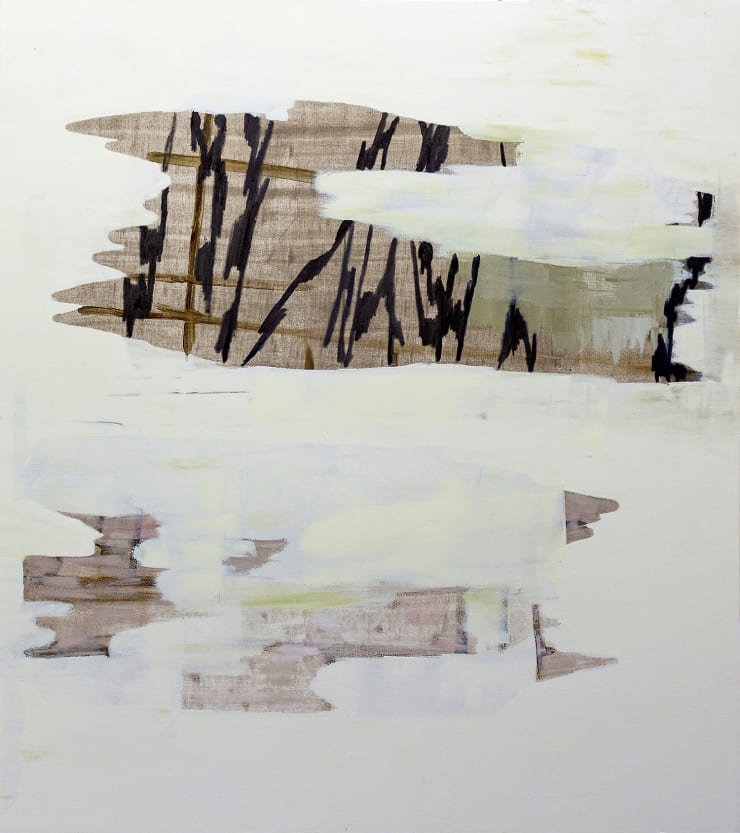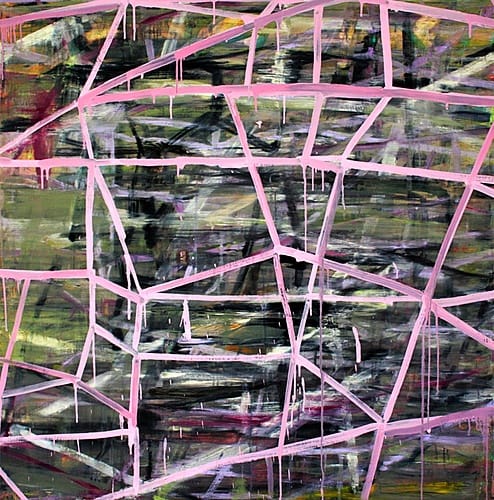-
DEBORAH DANCY: WHAT MIGHT BECOME
curated by melissa messina
-

Cataract, 2020, oil on canvas, 56 x 50 inches
-
"I’m an intuitive painter. I don’t overly construct a direction or preconceive a painting. I go where the impulse starts to take me, and then I follow. Sometimes I drive the work and sometimes the work drives me."
– Deborah Dancy
-
Deborah Dancy does not privilege painting over drawing, but rather finds the drawing process to be its own “distinctive engagement.” Many elements in her drawings find their way into paintings, allowing the works on paper to remain locations where processes such as drips, scrapes, scumbles and linework happen more intuitively. In addition to metaphoric use of color and metonymic use of shape, her painting process often includes a blurring and uncovering of her mark making. A central element to her work, this obscuration is not only a device to keep the viewer intrigued, but also to maintain a defiant secrecy. Abstraction allows Dancy to reveal only as much as she wishes of her ideas and provides the viewer space for personal interpretation.
-
"I do things with drawing that frankly I hesitate to do with painting. With drawing, I pour medium and paint and crush stone onto the surface. They feel rowdy and unruly. I think in many ways I’m braver with the drawings. There are elements of the process that happen in drawings that emerge in the paintings, but in the paintings it’s slower, the pace is different, and results end up being more toned down, perhaps more nuanced."
– Deborah Dancy
-
Dancy utilizes the poetic and interpretive nuances of abstraction with great intention. This particular grouping demonstrates the ways in which color informs Dancy’s compositions. Here, a bright periwinkle blue demarcates space, engaging in a push and pull with fine and brushy black linework. The tonal qualities of her palette are also infused with emotion. Often the same color can feel tranquil and bright in one work and present as more somber and subdued in another.
-
"I gravitate toward certain colors, I don’t know why. In general I seem to gravitate toward greys, ochres, citron/ greens, warm and cool yellows and pinks (I like using pink because it can be made to feel sweet but also repulsive), and on occasional ultramarine blue. I like to play with color that appears soothing and then create a clash, a bam, an unexpected shift in intensity or value. There are colors that just don’t really speak to me—they don’t even ask and therefore I’m not inclined to seek them out."
– Deborah Dancy
-
In Dancy’s work, activations of line and form often embody a sense of urgency and unrest. The pieces in this grouping are vigorously generated with a visceral paint quality sometimes blended directly on the paper or canvas. Dancy describes the Weight of a Million Black Stars drawings, for example, as happening out of anger and frustration after the events of police violence against Black and Brown people. In them we find poured paint and crushed stone dust making a weight and density that is, as the artist describes, “both heavy and fragile.”
-
"For me, the shift into abstraction happened in 1974, after the death of my mother. I needed to make work, and the only viable, potent, wretched, heartfelt imagery that explored my grief was possible through abstraction. It’s my language of exploring what isn’t a literal picture of an event or an emotion—it’s embodiment, something felt. After that, I couldn’t turn back, didn’t want to."
– Deborah Dancy
-
Evident in Dancy's work is a portrayal of the cycles of life-motion and stasis, germination and destruction, abundance and scarcity. Her paintings and works on paper make for loaded, emotive environments. Connected to both the body and the landscape through an organic abstraction, they also reflect how the range of human response is mirrored in natural phenomena. This grouping offers a muted palette, ghostly swathes and finer lines; a subtle and more minimal approach suggestive of quieter, more reflective spaces with bolder linework interrupting the calm.
-
"Formal elements are there in the work—as much as I try to get around that, it’s me, it’s who I am. But at the same time, I try to disrupt it as much as I can. What is important to me is to be honest with who I am as an artist. Conceptually, ideas come from a variety of inspirations and sources; everyday events, moments of remembered experiences or sensations, the landscape that surrounds my home, my travels—they all find their way into the paintings."
– Deborah Dancy
-
Connected formally and conceptually by the intense period of time in which they were made – all from 2020 – the pieces in this grouping showcase how elements in Throw Me a Lifeline can be found in a number of Dancy’s drawing series. In creating the painting, linear elements developed spontaneously in what the artist describes as “a raw exquisite moment that cannot be orchestrated [and that] you trust is valuable and legitimate.”Its revelations clearly bled into the drawings, with connections made visible in creamy horizontal banding across the Morass series, diagonal lines mapping their direction in Smoke and Mirrors, and tangerine foci circulating throughout the Transmission compositions.
-
Ebb and flow is a part of life, isn’t it? I’m 71. I had a good childhood and life, and I’ve experienced a lot. I grew up in the ‘50s and ‘60s in Chicago, experienced segregation there as well as in the South where we spent time in the summer. I participated in civil rights marches, anti-Vietnam protests, married, served in the Peace Corps in the early ‘70s, had children, lost parents, taught for 35 years, divorced, and I continued making work. Ebb and flow, transformation, germination and destruction are in my work because my work, in part, is an extension of life, my life. Making the work, the physical act of painting, is transformative. It's a ritualistic dance of starting, then scraping away, repainting and finding something worth saving—I think that’s ebb and flow.
– Deborah Dancy
-
Paintings
Summary View -
Drawings
Summary View -

-
PRESS
-

Deborah Dancy in ArtPulse
'It's a constant struggle to keep the 'thingness' at bay': an interview with Deborah Dancy Although her art is thoroughly abstract, Deborah Dancy’s paintings, drawings, and works in other mediums... -

Deborah Dancy in The Bottom Line
June 26, 2013Currently on view until June 29 at Sears Peyton Gallery is a collection of luminescent paintings and drawings in the exhibition Deborah Dancy: Chasing the Light. The entire exhibition, including... -

Deborah Dancy in The Paris Review
June 22, 2017The Bookness of Not-Books I once owned a hardback edition of Somerset Maugham’s The Moon and Sixpence that had served time at the top of a bedside pile; its cover... -

Deborah Dancy in Two Coats of Paint
June 1, 2013Triangular: Andrew Seto and Deborah Dancy Isoceles, equilateral, scalene, right, obtuse, acute and equilateral. The humble triangles that we all studied in geometry figure prominently in contemporary abstraction, particularly in...
-






















